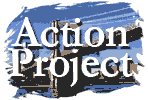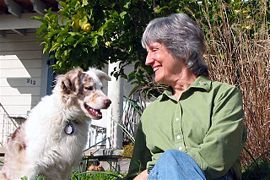
| Homework To Complete | In Class | |
WEEK 1
|
Introduce Class Discuss Syllabus Three Projects--One Theme: Action, Identity, Community--the Physical and the Digital What is Web Design What is Web Design? Meaning and Presentation: CSS Zen Garden Action Project Introduce first project and due date: "The Action Project" What is HTML? "Next, we're going to take two-and-a-half weeks to learn the mechanics of web design with Dreamweaver and Photoshop...." Exercise: Marking Up with HTML For this exercise, we'll use the program -- (on a Mac) "TextEdit" (use your computer's "Spotlight" search to find it; -- (on a PC), use "Notepad" ). Right-click on the whale image above, and save it onto your desktop in a new folder called "markup" When we complete the exercise, we'll save the result as "index.html" to the "markup" folder. We'll visit the page with a web browser Then we'll open the page in Dreamweaver (we will learn more about the tag inspector on the lower left) Finally, we'll save the "markup" folder onto a USB drive or in the "My Files" folder on your desktop (to be retrieved later). |
|
R 9/6
|
1. Obtain all books and buy or designate a USB drive for use in this class. 2. Create the following set of nested folders on your USB drive (with all lower-case letters!): webdesign www 4230 exercises action assets scene assets glocal assets 3. Read the beginning of McFarland's Chapter 1, pages 19-38. Mark passages and details you don't understand and would like to discuss in class. 4. Bring the McFarland book to class 5. Read over syllabus and bring in additional questions |
About the Class 1. Questions on the syllabus? 2. Dimensions of the Class 3. Questions on McFarland's pages 19-38 Idiom of Web Design 4. See the examples on the Action Project Page. Follow-Up Markup Exercise 5. copy "markup" folder into the folder "www/4230/exercises" 6. With Dreamweaver, open the "index.html" page inside "markup." (Tag Inspector,Code View) Files and Folders Missing CDs Getting Started with Dreamweaver 7. Set Up for McFarland's Chapter 1 "Test Drive" Tutorial (pages 38 - 63, due next time) |
| WEEK 2 T 9/11  |
1. Complete McFarland's Chapter 1: Dreamweaver Test Drive tutorial, pages 38-63. You will need to complete this chapter sitting at a computer with Photoshop installed. See - Computer Labs ("Full Service" including Dreamweaver and Photoshop) - Computer Lab Schedules (UMD) - Abobe Dreamweaver Trial Version of CS5! (30 days only) 2. Read Chapters 2 and 3 of McFarland. |
Test Drive (C1) McFarland Help Session McFarland C1 Setting Up "www" Sites and Posting to the Web We will also export your "www" Site Info onto your USB ("www.ste" file) so you won't need to go through the process of setting up this site again and again. Action Project Talk about real action and "The Action Project" |
| R 9/13 | 1. Read Chapter 4 of McFarland, and 2. Complete the tutorial in Chapter 4 "Introducing Cascading Style Sheets" 3. Read McFarland's Chapter 5, "Links" and complete the Links Tutorial at the end |
Cascading Style Sheets (C4) McFarland Help Session McFarland C4 Links (C5) Help Session McFarland C5 (Note that for the next tutorial, I will ask you to upload the exercise and post the URL before class begins.) Action Project Talk about audience, style, and "The Action Project" (Barefood Proximity) Banners in Photoshop (Photoshop). -- Save the working .psd file to your "webdesign" folder -- Save the finished product (.jpg file) to a folder called "www/4230/exercises/banner" -- send the URL to the Moodle forum "Banners" |
| WEEK 3 T 9/18  |
1. 2. 3. Aristotle: "Rhetoric is the faculty of observing, in any given case, the available means of persuasion." |
Images (Chapter 6) Help Session McFarland C6 "Images" Tables (Chapter 7) Help Session McFarland C7 "Tables" Banners in Photoshop 2 Resource: "Classic 45's CSS Zen Garden" from CSS Zen Garden) Action Focused Web Sites Discuss the Action-Focused Web Sites: The "means of persuasion" realized in oppositions (dialogics) and narrative. Your Examples: Action-Focused Web Sites (oppositions and narratives) |
| R 9/20 | 1. Note: Be sure to start with a layout page generated from the version of Dreamweaver that the book uses. If you need a Dreamweaver CS3 page, use your web browser to save this page into your "Chapter09" folder as "hydroponics.html." To save a page you're viewing with most web browsers, choose File > Save. Post the final product to the web, and send the URL to the "McFarland C9" Moodle forum. 2. In the Moodle forum "Action-Focused Web Sites," look over the postings and reply to one (not your own) with a paragraph analysis of how the rhetoric (means of persasion) of that site attempts to prompt a specific action. |
Page Layout (Chapter 9) Help Session McFarland C9 "Page Layout" How To: Your own pages from DW's "CSS Layouts" (see McFarland 324). Visual Hierarchy and Screen Real Estate Lecture: Visual hierarchy and screen real estate Discussion: Homework applying principles of visual hierarchy and screen real estae. Action Focused Web Sites Discuss the Action-Focused Web Sites: The "means of persuasion" realized in oppositions (dialogics) and narrative. Your Examples: Action-Focused Web Sites (oppositions and narratives) |
| WEEK 4 T 9/25  |
1. Analyze and Rate the following pages from CSS Zen Garden (1-5 with 5 being best) for - use of visual hierarchy, - use of screen real estate, - expression of theme(s) - readability/usability - CSS Co., Ltd. - Retro Theater - Pretty in Pink - One more of your own choice 2. Nielsen and Tahir 1. Read "Preface:" (1), "Homepage Guidelines" (7-35). In this chapter, the authors identify 113 numbered guidelines for making pages more usable. 2. Write down the item numbers of 20 of the guidelines that you think are valuable, surprising, wrong, or most characteristic of Nielsen's and Tahir's approach. 3. On a large sheet of paper, create a cluster or cloud of these twenty items, each identified by Nielsen and Tahir's item number and a two- or three-word tag. As you write items in the cluster, see if you can indicate your emerging sense of patterns and connections by where you position each term. 4. Draw connecting lines among the items in your cluster to show relationships and groupings. The more significant, useful, or surprising the connection, the darker and heavier the connecting line. 5. Draw circles (or darker circles) around terms/items that seem most important, central, or "weighted" 6. Add your own words to the cluster to name these connections and the authors' larger principles. You can use your own terminology. 7. On the bottom of the page (or the back if you need room), make a list of three or four principles that you discovered through your clustering that epitomize Nielsen's and Tahir's approach and philosophy. 8. For one of your principles, provide a URL to an example online, and write a brief explanation of what specifically we should look for on that page. Note that you can also provide a negative example of a page that doesn't follow a principle. Post them as screen shots inserted as visible images in the Moodle messages, with a URL to the page itself, and a brief explanation. Make the image no wider than 600 pixels. Directions for taking a "screen shot" Directions for inserting visible images in a Moodle forum 3. In Nielsen and Tahir's Homepage Usability, read Homepage Design Statistics" (37-53) and "Introduction to the Home Pages" (55), and commentarites on the homepages through BBC Online (87) Post the examples in replies to the original message identifying the principle in the Moodle forum with the page and comment number and a brief explanation. |
Visual Hierarchy Discussion: Your analyses of the visual hierarchy and screen real estate in 4 pages from CSS Zen Garden. Homepage Usability: Nielsen and Tahir Discussion: Nielsen and Tahir's Big Picture (home work for today) Example: tag lines (#2, pg. 10) Bad Boys Bail Bonds Collect: Guideline Clusters CSS Layout Pages (DW) Exercise: CSS Layout Pages We'll save the page as "index.html" into the folder "www/4230/exercises/banner--where you previously saved the result of the Banner Techniques exercise. Then we'll insert the banner into the page. You'll then send the clickable URL of the page (with the banner showing) to the forum, "New CSS Layout Page." |
| R 9/27 | |
No Class Meeting |
October
| Homework To Complete | In Class | |
| WEEK 5 T 10/2  |
Bring all materials necessary to work on your Action Project page in class. |
Studio Session for Action Project Handout for Next Meeting: the first page from Lev Manovich's "Poetics of Augmented Space") Resource:Forms tutorial. (Note: if you put form fields on your Action Project page, you are not required to make them work as this tutorial direct.) |
| W 10/3 | ||
R 10/4 |
Change of Location: We will meet in Humanities 314 for the next few class meetings Write, Print, and Bring In: your Action Project commentary, which should fulfilll the guidelines of excellent commentaries. Copy and Paste the text of your Commentary into a blank web page and post it as "commentary.html" to your "action" folder online. In a reply to your previous message in the Moodle forum "Action URLs," post the URL to that commentary page. Read Accidental Billionaires, 3-84 and the first page of Lev Manovich's "Poetics of Augmented Space" Write, Print, and Bring In: Reading Guide 1 due by the beginning of class. Please open the Word file available via this link, type in your responses, then delete the original questions to save space. Print out the Reading Guide and bring it to class. |
In Humanities 314: Virtuality and Physicality Mezrich: Accidental Billionaires, 3-84 Collect: Action Project Commentary Comment: The Digital Culture and Theory Unit, the Midterm Exam, and the Scene to Scheme Project (Character Home Page from Telling Scene) Handout: Format of a sample midterm exam Comment: Why this book? Discussion: Virtuality and Physicality (including Lev Manovich's "Poetics of Augmented Space") Discussion: Insides/Outsides/Nosides (Harvard as a "geography of power") Collect: Reading Guide 1 |
| WEEK 6 T 10/9 |
Read Accidental Billionaires, 85-159 Write, Print, and Bring In: Reading Guide 2 due by the beginning of class |
In Humanities 314: Mezrich: Accidental Billionaires, 85-159 Handout: Format of a sample midterm exam Harvard constructed as a symbol of the geography of power Winklevosses constructed as a symbol of physicality (Harvard physicality) Virtuality ahd Physicality (Lev Manovich's "Poetics of Augmented Space") Close reading of a passage (groups) Resources: Board of themes from last time Kinneavy's Four Aims of Discourse Mark Zuckerberg's Home Page |
| R 10/11 | 1. Read Accidental Billionaires, 160-252 2. Find: As a "geography of power," how does Palo Alto different from Harvard as Mezrich represents it in Accidental Billioinaires? Come in with two quotations chosen (with page numbers) that suggest or dramatize the power structures of the digital economy of Palo Alto as opposed to the physical (represented by Harvard). 3. Your question should point to a particular passage, with a page number, as a starting point for answering it. The question might concern a theme or issue we've discussed previously, or be a new one. Your question should ask us to find additional passages in the book--with page numbers--that support a fuller understanding of the answer. Come in with at least two such passages noted down. |
In Humanities 314: Open Forum: Mezrich: Accidental Billionaires 1. Places as Ways of Life, People as creatures of Places Harvard vs. Palo Alto (as Old vs. New Economy) The Winklevosses as creatures of Harvard, Sean Parker as a "Silicon Valley animal" (145) 2. Your open-ended questions In your group, decide on a question to discuss that A. might get us to something essential about "digital culture" B. encompasses or suggests other questions Resources: New York Times: Capturing the Facebook Obsession Silicon Valley Map La Jennifer Way, Palo Alto) |
| WEEK 7 T 10/16  |
1. Download, print out, read, and mark David Weinberger's Everything is Miscellaneous. Prologue, Chapter 1 and Chapter 3, all available from the "Readings" section of Moodle. 3. Download, print out, read, and mark Chris Anderson's The End of Theory. |
In Humanities 314: David Weinberger: Everything is Miscellaneous Preparing for Keen: Believing and Doubting Games Discussion: Miscellaneousness vs. Geography Resources Trojan Horse Semiotic Map: Intended/Unintended/Social/Individual Chris Anderson: The End of Theory Resource: Google Books Ngram Viewer |
| R 10/18 | 3. Download, printout and read Andrew Keen's Cult of the Amateur: Introduction and Chapter 1 available from the Moodle site under "Readings" 4. Complete the Keen Reading Guide by copying and pasting the following questions into a file you can save, edit, and print: 1. What is the "cult of the amateur," according to Keen (include page numbers for quoted/cited words and phrases)? 2. Summarize the main points of Keen's critique of the "cult of the amateur" (include page numbers for these points) 3. In your opinion, what is the best point Keen makes (with page number and key phrasing indicated)? 1. Download, printout, and read Pierre Levy, available from the "Readings" section of Moodle. 2. Complete the Levy reading guide, and print it out to turn in. |
In Humanities 314: Andrew Keen Resource: The first two pages of Keen's concluding chapter Pierre Levy Anthropoligical Space, Knowledge Space, Subjectivity Preparation for Reading Heim (Platonic philosophy and "cyberspace"): Plato's Allegory of the Cave Preparation for Reading Haraway's "A Manifesto for Cyborgs" (Technology, Political Progressivism, and the 1970s and '80s: Crosby, Still, Nash, and Young's "Woodstock") |
| WEEK 8 T 10/23  |
3. Download, printout, and read Michael Heim's "Erotic Onology of Cyberspace," available from the Moodle site under "Readings." 4. Complete the reading guide and print it out to turn in. Download, print out, and read Donna Haraway's "A Manifesto for Cyborgs" available from the Moodle site under "Readings" Copy and paste the following questions into a file you can save, edit, and print. 1. What does Haraway mean by saying, "We are cyborgs" (28) 2. According to Haraway, how are we to respond or react to being cyborgs? |
In Humanities 314: Michael Heim Follow-Up to Return of the Action Projects: Guided Revision Option Plato's Allegory of the Cave Donna Haraway  Resources - Biofeedback and Neurofeedback at the Vancouver Olympics 2010 (YouTube) - Ethical Implications of Technology are an Olympic Concern - Crosby, Still, Nash, and Young's "Woodstock") - What the Doormouse Said (book) - Haraway interview with Wired Magazine - Star Trek Next Generation (Borg) |
| R 10/25 | Download, print out, and read--starting with paragraph 9 that begins, "But having said, this, let me turn very briefly...."--Roland Robertson's "Comments on the 'Global Triad' and 'Glocalization' Bring the Web 3.0 handout |
In Humanities 314: Roland Robertson Web 3.0 Follow-Up to Return of the Action Projects: Guided Revision Option Discuss: globalization, anti-globalism, relativization, glocalization, totemic places, particular and universal. Resources: Sacred Places of Europe Avery Island (Tabasco Sauce) Discuss the Web 3.0 handout Review the Sample Exam Format |
| WEEK 9 T 10/30  |
Listen to the "The Future of the Internet" and complete the online "The Future of the Internet" listening index |
In Humanities 314: The Future of the Internet "The Future of the Internet" In-Class Workshop Resources: - hierarchies vs. networks - Wendy Hall - Future of Internet Sample Cluster - Hans Rosling: Stats that Reshape Your World (TED Talk, commentary on free data starting at 13:50)  |
November
R 11/1  |
1. Bring all books, readings, and handouts to class 2. Now that we've completed the "Future of the Internet" workshop, I will ask you to go back and listen carefully to those sections having to with the three key ideas we picked. (If we didn't finally select three, then include your own choice(s) to make three. Use the Moodle forum posting to find the time-locations of these ideas in the program file. 3. Use the Moodle forum "The Future of the Internet" to identify and learn the specific names of individuals speaking about these three topics. Try searching on the web to find background on that idea and that person to help you better understand that person's perspecrtive and what he/she is saying. 4. Make note of further connections with other ideas which help you better unpack, contextualize, and understand these three ideas. 5. By noon of this day of our meeting, write a substantive paragraph about one of those ideas in a reply to your own messgae in the "Future of the Internet" Moodle forum. Include in this posting a. the names of sources or speakers (either from the BBC program or elsewhere) b. at least one quotation (with source indicated) c. at least one clickable link to a source relevant to this idea d. a picture inserted as a visible image in your Moodle posting (see the next step) 6. Find an image that visualizes the key idea and that serves as part of an "intellecutal postcard." In your message, insert that image as a visible picture (See also the directions for inserting images in Moodle and start with Step 5; failing that, insert a clickable link to the image online.) |
Review for Mid-Term Exam Choose an additional term to represent the BBC radio program "The Future of the Internet."  In this session, you will use the provided Midterm Exam Study Tree to follow these directions. |
| WEEK 10 M 11/5 |
As an example, here is the sample question I gave you previously: "In a short paragraph, explain Michael Heim's use of the term "erotic." Beyond the conventional meaning of the word, what human impulse is he referring to, and what does it have to do with 'cyberspace'?" What makes a good "Short Answer" question? 1. It calls for more than simple recall; instead, the question can be answered well or badly in a paragraph (not just a sentence, and not needing a whole page). 2. It focuses on a key idea or term from a reading which is fundamental to understanding what that reading says. This term or idea can be understood on a number of levels. 3. It uses an action word like "explain," "analyze," "compare" to indicate what intellectual process is expected. 4. It suggests the potential significance of the answer to the larger purpose of understanding "digital culture," clearly inviting the writer to elaborate on that meaning or connection. |
Monday - Not a Meeting Day |
| T 11/6 top |
Bring a blue or black pen that you trust. | In Humanities 314: Midterm Exam Bring a reliable blue or black pen No blue books needed Since this is a closed-book exam, no books, printouts, or notes can be used. Receive handout: Remember Earth Clearly |
R 11/8  |
Read the handout "Remember Earth Clearly." In this passage from Douglas Coupland's 1991 novel Generation X, the characters are playing a game in which they tell "memories of earth": snapshot-like moments they remember which epitomize their individual experience of life.
What are the elements of a "memory of earth"? If we wanted to create a kind of form or format for writing a Memory of Earth or other such "telling scenes," what kinds of blanks would we give ourselves to fill in? |
Back to SSB 216: Introduce Scene to Scheme Project Introduce Scene to Scheme Project |
| WEEK 11 T 11/13 top  |
1. By email or other means, continue working in your groups to present and discuss your "Design-Scheme Mockup from a Memory of Earth." 2. Come in with two possible passages for the Scene to Scheme. Each of these passages should be "telling scene" that uses sensory details and specifically worded language to reveal some insight into a character. |
Back in SSB 216: Design Schemes from "Memories..." Review Scene to Scheme Project Resources:- Yellowtree Theatre - Design Themes and Schemes: Three Dimensions (using "Make Em' Proud!" from CSS Zen Garden) - Stave One, A Christmas Carol by Charles Dickens |
| R 11/15 | 1. Continue to look and think about editable content for home pages. We will vote on requirements in class today. 2. In the Moodle forum "Model Visual Pages," provide clickable URLs to at least two home pages (ideally, personal pages) that are primarily visual--rather than textual--in their logic of design. 3. Look at the two passages that you've chosen as possibilities for the Scene to Scheme Project. For each, make a list of a. potential themes, b. symbols (things to include) and c. possible design choices (visual and verbal atmosphere). |
Image-Based Web Pages with CSS (Visual Web Design with Photoshop) Discuss Scenes: model using Christmas Carol Exercise Image-Based Web Pages with CSS: I will give you a copy of the handout "Image-Based Web Pages with CSS." We will use the page at Yellowtree Theatre as a model You will save the exercise in a folder called "imagebased" inside of "exercises" (that is, www/4230/exercises/slice). |
| WEEK 12 T 11/20  |
|
Image-Based Web Pages with CSS 2 Exercise: complete "Image-Based Web Pages with CSS." including a banner, additional image or media, and additional text Resources: Visual Hierarchy McFarland's pages 317-323 Return of exams today |
| R 11/22 | Thanksgiving: No Class Meeting |
|
| WEEK 13 T 11/27 |
Bring all materials to class to work on your Scene to Scheme Project in class. |
Studio Session: Scene to Scheme Project |
| W 11/28 |
Scene to Scheme Project due by 9 a.m. today. |
Scene-to-Scheme Due 9 a.m. |
R 11/29 |
1. Write a commentary on your Scene to Scheme Project to turn in at the beginning of class today. In addition to the general guideliens for commentaries, this commentary... * include a printed copy of scene (1-3 pages) * should explain how you used the scene to invent an original design scheme. * should refer to specific features and aspects of your design and point both - to particular details and quotations from the original scene and - to the feelings and ideas you wanted to convey to the audience, whether explicitly or by implication 2. Come in with three possible topics for the Glocalizaiton Project. Each topic may be either something local, or a global/universal interest that may have some local instance) |
Introduce Glocalization Project Resources- "Comments on the 'Global Triad' and 'Glocalization' (Roland Robertson) |
December
| WEEK 14 T 12/4  |
1. By noon today, use this form to send me a "topic/angle" for a potential Glocalization Project. This may or may not be the topic/angle you ultimately use. The topic/angle may be in the form of an "as" phrase ("The Masters as a Rite of Spring"), or as a declarative sentence ("The Masters is a Fashion Show") or a description of purpose ("I will look at The Masters to show how..."). The topic/angle might be as short as a sentence fragment or as long as two sentences. |
Glocalization Topics and Angles Discussion and Activity: Topics and Angles for the Glocalization Project 2. I will ask you to break into groups of 3 and work together on a posting to the Moodle forum "Site Design Problems and Solutions." In this posting, make a list of 5 challenges and problems raised by taking the body of ideas in the The Story of I-35 and Duluth and realizing it in the form of a successful "Glocalization" web site. Consider issues of - rewriting the material, - designing the pages (home page, back pages) - conceiving of a site organization scheme, - combining words and images - generally producing the site. For each of the five problems/challenges, try to come up with at least one answer. 3. Tiling Backgrounds If there is time, we may begin the Tiling Background Exercise Resources: Random Word Generator The Story of I-35 and Duluth "Comments on the 'Global Triad' and 'Glocalization Tabasco's Avery Island/Jungle Gardens page |
| R 12/6 | 1. Collect and create material for your Glocalizaiton Site Project.
2. Remember that, before you start, you will need to copy the folder "Chapter19" from "MM_DWCS3" to your "exercises" folder inside of "4230." Be sure not to skip the step on page 701 for setting up a specific site for this exercise, with the local root folder being "Chapter19" in your "exercises" folder (that is, "www/4230/exercises/Chapter19" on your USB drive). Once you have completed the tutorial, use your "www" site in Dreamweaver to upload the "Chapter19" folder to the web, visit "hydroponics.html" and "planter.html" with your browser, and copy the URLs as a clickable links into a reply to the forum, "McFarland C19" |
Templates Hybrid Visual/Verbal Page Design 1. Troubleshoot: Templates Tutorial (McFarland's C19) 2. Exercise: Image-Intensive-Background Web Page Design. I will give you a copy of the the inclass handout. We will borrow the background image from Tabasco's Avery Island/Jungle Gardens page. Create the page inside a folder "image_intensive" inside of your "exercises" folder. Upload the folder to the web and send a clickable URL via the Moodle forum, "Image-Intensive-Background Web Pages" 3. Discuss "Sharpening Glocalization Topics/Angles" |
| WEEK 15 T 12/11  |
Work on your Glocalization Project | Tiling Backgrounds, Image-Intensive Backgrounds Set the tiling image as the background of a new page in Dreamweaver, post it to the web in the folder www/4230/exercises/tiling, and send the URL to the Moodle forum "Tiling Background" Resource: Avery Island/Jungle Gardens |
| R 12/13 LAST CLASS |
Bring all materials to work on your Glocalization Project | Studio Day: Glocalization Project Course Evaluations New Version of Web Pages with Image-Intensive Backgrounds |
| WEEK 16 FINALS WEEK: |
By our scheduled final exam time of December 19 at 2 p.m., post the URL of the Glocalization Project to the forum "Glocal URLs." The 500-word commentary should be submitted to my mailbox in H420 before the same time. No electronic copies accepted. Please turn in the commentary early if you need to. |
Glocalizaiton Project and Commentary due |